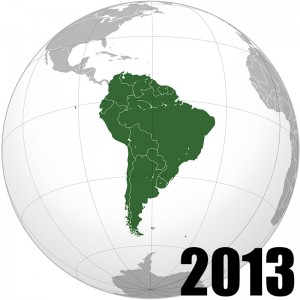 South America Population 2013
South America Population 2013
According to national estimates and statistical calculations, South America’s Population in 2013 is approximately 386,000,000. South America is a continent located in the Western Hemisphere and mostly in the Southern Hemisphere, with a relatively small portion in the Northern Hemisphere. It is also considered a subcontinent of the Americas. The present population of South America is the result of four centuries of mixture among these four components—American Indians, Iberians, Africans, and more recent overseas immigrants—and their descendants. The mixing process began when the first Iberians reached South America. The previous traditions and basic values and attitudes of the Iberians—coupled with other characteristics of their conquest and colonization—facilitated intermixing not only with the Indians but in general among all the various ethnic groups, although the intensity, extent, and frequency of this mixing varied both among different groups and at different times.
South America Land Mass
South America has an area of 17,840,000 square kilometers (6,890,000 sq mi). Its population as of 2005 has been estimated at more than 371,090,000. South America ranks fourth in area (after Asia, Africa, and North America) and fifth in population (after Asia, Africa, Europe, and North America).
South America Geography
It is bordered on the west by the Pacific Ocean and on the north and east by the Atlantic Ocean; North America and the Caribbean Sea lie to the northwest. It includes twelve sovereign states – Argentina, Bolivia, Brazil, Chile, Colombia, Ecuador, Guyana, Paraguay, Peru, Suriname, Uruguay, and Venezuela – and two non-sovereign areas – French Guiana, an overseas region of France, and the Falkland Islands, a British Overseas Territory. In addition to this, Trinidad and Tobago and the ABC islands of the Netherlands may also be considered part of South America.
South America Politics
During the first decade of the 21st century, South American governments have drifted to the political left, with socialist leaders being elected in Chile, Uruguay, Brazil, Argentina, Ecuador, Bolivia, Paraguay, Peru and Venezuela. Most South American countries use free market policies, and it is taking an active path toward greater continental integration.
South America Population Geography
Most of the population lives near the western or eastern coasts of the continent while the interior and the far south are sparsely populated. The geography of western South America is dominated by the Andes mountains; in contrast, the eastern part contains both highland regions and large river basins such as the Amazon, Paraná and Orinoco. Most of the continent lies in the tropics.
 South America Wildlife
South America Wildlife
Home to marsupials, monkeys and the world’s largest rainforest, South America is the continent with everything from glaciers to deserts. It became a continent in its own right on breaking away from Africa and Antarctica 120 million years ago. Its fauna and flora are therefore descended from organisms either on the continent then or that managed to make their way there during its isolation whose ancestors crossed the early Atlantic Ocean from Africa. Three million years ago, the Isthmus of Panama formed, uniting North and South America and allowing animals including big cats, bears, coral snakes and condors to move in.
South America Population By Country
| Rank | Country | Population |
| 1 | Brazil | 195,632,000 |
| 2 | Colombia | 47,130,000 |
| 3 | Argentina | 41,350,000 |
| 4 | Peru | 30,476,000 |
| 5 | Venezuela | 29,760,000 |
| 6 | Chile | 16,841,000 |
| 7 | Ecuador | 15,779,000 |
| 8 | Bolivia | 10,517,000 |
| 9 | Paraguay | 6,849,000 |
| 10 | Uruguay | 3,297,000 |
| 11 | Guyana | 798,000 |
| 12 | Suriname | 539,000 |
| 13 | French Guiana | 259,000 |
| 14 | Falkland Islands (UK) | 3,000 |
South America Demographic Patterns
The continent’s demographics reflect an unusual settlement history: South America is a “hollow continent,” with most of the population concentrated around its margins. The highest population densities are found in the old Indian core areas of the Andes, the former slave areas of northeastern Brazil, and the areas of European immigration in southern Brazil, Uruguay, and Argentina. The interior is relatively empty because of the decline in Indian populations, poor communications with coastal areas, and the absence of economic opportunities capable of attracting large numbers of immigrants.
South America Population
Other Resources
To learn more about the population of South America, click here
Learn more about Australia Population 2013.
Interactive World Population by Continent Map


